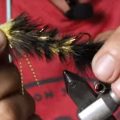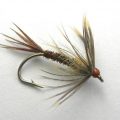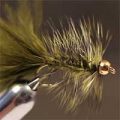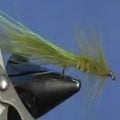Tag: woolly bugger
The Woolly Bugger Isn't All That - Or Is It?
This great piece today comes to us from Kent Klewein, over at Gink & Gasoline. I love the editorial direction Louis Cahill takes his blog in, and that's embodied in Klewein's opening sentence: This isn't Montana, you're not Norman MacLean, and the Woolly Bugger isn't all that. This is a fun, interesting read about the Woolly Bugger and how it's...
Video Hatch: “Articulated Micro-Spine Bugger Changer”
Take the classic Woolly Bugger to the next level in this tying tutorial from Flymen Fishing Company. “While the original Woolly Bugger gets its movement in the water from the undulation of its marabou and hackle body materials, the Bugger Changer combines this body material undulation with lifelike articulation, made possible at this micro scale with the...
Experts' Top Ten Dry and Wet Flies
Have a question you want answered? Email it to us at [email protected]. Question: How do you organize your fresh water fly boxes? Do you have a Top-10 list of dry & wet flies that you'll always carry? Mark C., Chattanooga, TN Answer: There are lots of ways to organize your flies: by season, by species, by kind of water, by fly style, by color, and so...
Back to the Future: The Flies of Greg Senyo
If you tie streamers—heck if you tie anything—then you probably know the name Greg Senyo, which appears on a variety of products with a number of companies: Lazer Dub, Shaggy Dub, Predator Wrap, Articulated Shanks. And that's just a short list. Steelheaders know him for his swing patterns, which are spectacular in the true sense of the word: they are...
Tying an Olive Woolly Bugger
Tim Flagler ties another freshwater classic, the Olive Woolly Bugger. Authored by fly tyer Russell Blessing of Pennsylvania in 1967 to resemble hellgrammites, or dobsonfly nymphs, this utilitarian streamer pattern continues to stand the test of time.
How to Tie an Olive Woolly Bugger
There are many different ways to tie a Woolly Bugger, notes Tim Flagler, but he suggests these steps for tying one of the best searching patterns of all time.
Fishing Woolly Buggers
RUSSELL BLESSING, who invented the pattern, says he usually starts out dead-drifting the Bugger, "to see what happens." If that doesn't produce, he will add jigging motions on the strip, jig it back at the end of the drift as Barry Beck described [see several paragraphs below], cast up and across the current and let it swing, use hand-strip retrieves...
Tying a Woolly Bugger
INSTRUCTOR DAVID CAMISS ties the classic Woolly Bugger fly pattern.

















